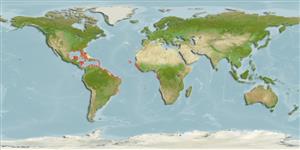Teleostei (teleosts) >
Gobiiformes (Gobies) >
Gobiidae (Gobies) > Gobiinae
Etymology: Bathygobius: Greek, bathys = deep + Latin, gobius = gudgeon (Ref. 45335).
More on author: Valenciennes.
Environment: milieu / climate zone / depth range / distribution range
Ecology
Marine; freshwater; brackish; demersal; non-migratory; depth range 0 - 16 m (Ref. 5299). Tropical; 16°C - 36°C (Ref. 97140); 46°N - 34°S, 99°W - 15°E
Eastern Atlantic: Senegal to Angola (Ref. 5299, 57403, 79590) including the islands of the Gulf of Guinea (Ref. 79590). Western Atlantic: Florida Keys in the USA, Bermuda and the Bahamas to Santa Catarina, Brazil (Ref. 7251, 57756). Mediterranean Sea (Ref. 50345). Suspected to be conspecific with Bathygobius fuscus. Record from Algeria needs confirmation (Ref. 2682).
Length at first maturity / Size / Weight / Age
Maturity: Lm 8.2 range ? - ? cm
Max length : 15.0 cm TL male/unsexed; (Ref. 57403)
Dorsal spines (total): 7; Dorsal soft rays (total): 8 - 9; Anal spines: 1; Anal soft rays: 7 - 9. Diagnosis: body with 3 broad, oblique, dark cross bars; numerous pale striae along sides, corresponding to the center of each longitudinal scale row; head and pectoral-fin bases with white spots and mottling; predorsal scales extend well anterior to level of preoperculum, and anterior margin of scaled area appears convex in dorsal view (Ref. 57403, 79590). 4-5 outer/upper pectoral-fin rays free (Ref. 57403, 79590), hence its name "Frillfin goby" (Ref. 26938). Body shape is terete, slightly depressed; eyes situated dorso-laterally; reduced swim bladders (Ref. 92840).
A resident intertidal species with homing behavior (Ref. 32612). Lives benthically over sandy and muddy substrates (Ref. 79590). Mainly found in pools (Ref. 4343). Abundant in rocky tide pools and along water's edge (Ref. 7251) in lagoons, creeks, estuaries (Ref. 5299, 57403, 79590) and (mangrove) swamps (Ref. 57403, 79590). Occasionally found in fresh waters (Ref. 57403, 79590), with salinity range of 0.0-38.8 ppt (Ref. 97140). Maximum standard length reported 113 mm (= 145 mm TL)(Ref. 79590).
Life cycle and mating behavior
Maturity | Reproduction | Spawning | Eggs | Fecundity | Larvae
Benthic spawner.
Harrison, I.J., P.J. Miller and F. Pezold, 2003. Gobiidae. p. 625-666 In C. Lévêque, D. Paugy and G.G. Teugels (eds.) Faune des poissons d'eaux douce et saumâtres de l'Afrique de l'Ouest, Tome 2. Coll. Faune et Flore tropicales 40. Musée Royal de l'Afrique Centrale, Tervuren, Belgique, Museum National d'Histoire Naturalle, Paris, France and Institut de Recherche pour le Développement, Paris, France. 815 p. (Ref. 57403)
IUCN Red List Status (Ref. 130435: Version 2024-2)
Threat to humans
Harmless
Human uses
Fisheries: of no interest; aquarium: commercial
Tools
Special reports
Download XML
Internet sources
Estimates based on models
Preferred temperature (Ref.
123201): 23.4 - 28, mean 27.3 °C (based on 1148 cells).
Phylogenetic diversity index (Ref.
82804): PD
50 = 0.5000 [Uniqueness, from 0.5 = low to 2.0 = high].
Bayesian length-weight: a=0.00794 (0.00689 - 0.00915), b=3.10 (3.06 - 3.14), in cm total length, based on LWR estimates for this species (Ref.
93245).
Trophic level (Ref.
69278): 3.7 ±0.55 se; based on food items.
Resilience (Ref.
120179): High, minimum population doubling time less than 15 months (Preliminary K or Fecundity.).
Fishing Vulnerability (Ref.
59153): Low vulnerability (22 of 100).
Nutrients (Ref.
124155): Calcium = 251 [122, 542] mg/100g; Iron = 1.21 [0.69, 2.19] mg/100g; Protein = 18.2 [16.4, 19.7] %; Omega3 = 0.243 [0.103, 0.481] g/100g; Selenium = 27.7 [13.8, 58.9] μg/100g; VitaminA = 37.8 [11.6, 106.2] μg/100g; Zinc = 1.81 [1.25, 2.68] mg/100g (wet weight);
